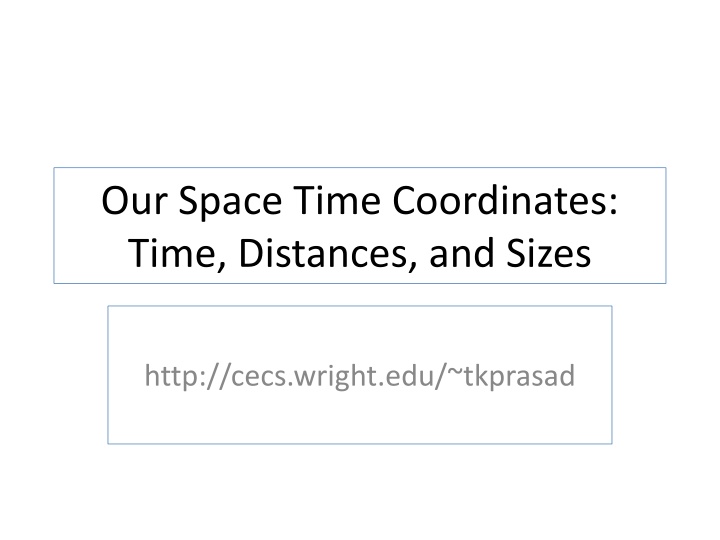
Our Space: From Solar System to Distant Stars
Explore the vastness of our universe, from the intricate details of our Solar System, with planets scaled down to football field sizes, to the mind-boggling distances between celestial bodies and stars measured in light seconds, minutes, and years. Visualize the scale of our cosmos, from Earth to the most distant galaxies billions of light years away, providing a humbling perspective on our place in the universe.
Download Presentation

Please find below an Image/Link to download the presentation.
The content on the website is provided AS IS for your information and personal use only. It may not be sold, licensed, or shared on other websites without obtaining consent from the author. If you encounter any issues during the download, it is possible that the publisher has removed the file from their server.
You are allowed to download the files provided on this website for personal or commercial use, subject to the condition that they are used lawfully. All files are the property of their respective owners.
The content on the website is provided AS IS for your information and personal use only. It may not be sold, licensed, or shared on other websites without obtaining consent from the author.
E N D
Presentation Transcript
Our Space Time Coordinates: Time, Distances, and Sizes http://cecs.wright.edu/~tkprasad
Universe Milky Way Galaxy Solar System (including the star Sun, the planet Earth, the moon Moon(!), etc) Planet Earth Seven Continents and Four Oceans North America, South America, Europe, Africa, Asia, Australia, Antartica Pacific, Atlantic, Indian, Arctic Countries, States, Cities United States of America, Ohio, Dayton Russ Engineering Center, Wright State University, 3640, Col. Glenn Highway
Measuring Distances Average Distance between Sun and Earth = 93 million miles (1 Astronomical Unit) (Speed of light = 186000 miles per second) (1 light second = 186000 miles ) = 500 light second = 8.33 light minutes
Visualizing Distances If 1 inch is the distance between sun and earth, then 1 mile is equivalent to 1 light year. 1 parsec = 3.26 light years
Solar System scaled to Football field Body Diameter Semi-major axis Sun 0.85 in (21.5 mm) zero Mercury 0.003 in (0.08 mm) 1.0 yard (0.9 m) Venus 0.007 in (0.19 mm) 1.9 yard (1.7 m) Earth 0.008 in (0.20 mm) 2.5 yard (2.3 m) Mars 0.004 in (0.10 mm) 3.8 yard (3.5 m) Ceres 0.001 in (0.02 mm) 7.0 yard (6.4 m) Jupiter 0.085 in (2.16 mm) 13.1 yard (12.0 m) Saturn 0.071 in (1.8 mm) 24.2 yard (22.1 m) Uranus 0.029 in (0.73 mm) 48.6 yard (44.4 m) Neptune 0.028 in (0.7 mm) 76.1 yard (69.6 m) Pluto 0.002 in (0.05 mm) 100.0 yard (91.4 m) Eris 0.002 in (0.05 mm) 171.4 yard (156.7 m) Centauri A 0.94 in (23.9 mm) 396 mile (637 km)
Distances to nearby objects Heavenly Body Average Distance from Earth Moon 1.3 light seconds Sun 8.3 light minutes Mars 12 light minutes (0.5 2.5 AU) Jupiter 42 light minutes Saturn 1.2 light hours Pluto 4 light hours Comets outer reaches of solar system Light months
Distances to Stars Stars Distinction Distance from Earth (light years) Proxima Centauri Nearest Star 4.2 light years Sirius Brightest Star (in night sky) 8.6 light years Pole star North star, Cepheid Variable 300 light years Rigel/Betelgeuse Blue/Red giant in Orion 800/600 light years Deneb Blue giant in Cygnus 1500 light years Andromeda Galaxy Nearest galaxy 2 million light years *HST Image* Most distant galaxy 13 billion light years
Universe Distances http://micro.magnet.fsu.edu/primer/java/scie nceopticsu/powersof10/index.html http://cass.ucsd.edu/public/tutorial/scale.html http://cass.ucsd.edu/public/tutorial/Intro.html
Universe Timeline http://www.pbs.org/deepspace/timeline/index.html http://www.historyoftheuniverse.com/tl1.html
Sizes of planets and stars Planets, Stars, Nebulae, Galaxies - Universe Size Comparison [HD High Definition] http://www.youtube.com/watch?v=WcZkAZebK1 U&NR=1 https://www.youtube.com/watch?v=oNb3H9kICbA
